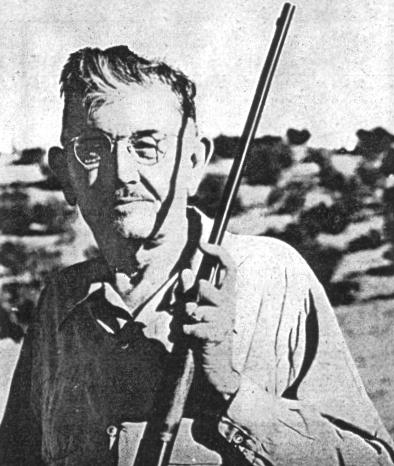Ad Toepper's "Arizona Tiler" - Golf with a Rifle
HISTORIER
3/14/20253 min read


Ad Toepper's "Arizona Tiler" - Golf with a Rifle
The sun beat down mercilessly on the small desert shooting range outside Tucson, Arizona, on a May day in 1959. A small group of shooters and spectators gathered around 42-year-old Ad Toepper, a local shooting instructor and former military marksman. What would happen this day would become a masterclass in precision shooting without parallel.
Toepper, known locally as "The Arizona Tiler" because of his distinctive performance, placed a golf ball on a regular tee at a distance of 100 yards (91 meters). Beside him stood his custom-built Winchester Model 70 rifle in caliber .220 Swift, equipped with a handmade telescopic sight.
"Do you really think you can hit that small ball from this distance?" asked a skeptical spectator.
Toepper smiled modestly. "Actually," he replied, "I'm going to hit it three times in rapid succession, and I will move it without shattering it."
Laughter broke out among some of the skeptics. Even with a first-class precision weapon, such a demonstration seemed physically impossible. A golf ball is only 42.67 millimeters in diameter, meaning that to hit the same object three times in a row from 100 yards, each shot would have to be placed with an accuracy of less than 1/50 of a degree.
The men fell silent as Toepper lay down in shooting position. He adjusted his leather shooting jacket, placed the rifle carefully against his shoulder, and began his breathing routine that he had perfected through thousands of hours of training.
The crack of the first shot rang out across the range. Through binoculars, the spectators could see the golf ball hop slightly but remain intact on the tee. Before anyone could comment, the second shot followed immediately - again the ball jumped but stayed on the tee. The third shot came with equal precision, and this time the ball rolled elegantly off the tee, still completely intact.
The silence was broken by spontaneous applause. Toepper had done the impossible - he had hit a golf ball at 100 yards with three consecutive shots, with such perfect placement that the bullets had only touched the edge of the ball just enough to push it, not enough to shatter it.
This was not a lucky accident. Ad Toepper, who had served as a sniper in World War II, had developed this specific demonstration to an artistic level. He could repeat the feat consistently and often expanded the challenge by using smaller objects or greater distances.
What distinguished Toepper's "Arizona Tiler" from other shooting presentations was the unique combination of precision and control. While many shooters could hit small targets, hitting the same object repeatedly with just enough force to move it without destroying it required an almost supernatural control over trigger, breath, and posture.
"The secret lies in understanding that you don't aim at the target," Toepper later explained to an apprentice. "You become the target. You must know exactly where the bullet will land before you fire the shot, not just try to point the weapon in the right direction."
Toepper used a modified form of "aiming off" - a technique where the shooter deliberately aims at a specific point near, but not directly at the target - to achieve the precise effect of "pushing" the ball without shattering it. This required an intimate understanding of both ballistics and the physical properties of the target.
His abilities became so legendary that the American shooting team recruited him as a technical advisor in the 1960s. The famous shooter and author Jack O'Connor described Toepper's skills as "balanced on the border between science and art - a form of precision that exceeds normal human potential."
Toepper himself remained modest about his abilities. When pressed to explain how he had developed such exceptional precision, he simply cited three factors: "Patience, perfectionism, and twenty years of daily practice."
The most astonishing part of the story about the "Arizona Tiler" is that Ad Toepper's records in precision shooting still stand unchallenged in certain shooting circles. Modern competitive shooters, even with today's advanced optics and weapons, find it extremely challenging to recreate his combination of precision and controlled power.
In an era before laser sights, computer-assisted aiming, and ballistic calculators, Toepper's demonstrations represented the pinnacle of human precision - a perfect interplay between eye, brain, and trigger finger that few, if any, have surpassed since.
Historic Shooters
Explore stories about the most remarkable shooters and their incredible achievements.
Biografier
geir@otimo.no
© 2025. All rights reserved.
